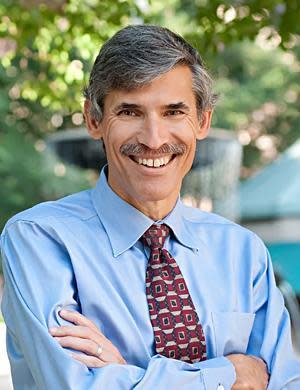Out running Parky: Exercise is key strategy against Parkinson's disease | Yon
- Oops!Something went wrong.Please try again later.

Ok, so I am late. We have reached May and Parkinson’s Awareness Month was April.
One of the side effects of Parkinson’s Disease (“Parkinson’s”) is Bradykinesia which is defined in general as “slowness of movement.” The Parkinson’s Foundation calls it one of the “cardinal” symptoms of Parkinson’s. You must have bradykinesia plus either tremor or rigidity for a Parkinson’s diagnosis to be considered.
Parkinson's information: Sweat Therapy presents session on living with Parkinson's disease
Testing: Genetic testing can play a role in predicting your health risks | Mark Ryan
Nutrition tips: Five simple ways to eat healthier during nutrition month and beyond
But with estimates of more than a million people with the disease in the U.S. and many thousands more being added each year there is good reason to write about it. Parkinson’s is generally recognized as the fastest growing neurological disease in the United States.
Very few people understand what Parkinson’s is – even professionals. It is hard to test for the disease and everyone is unique in their own set of symptoms. I certainly did not know much about it before my diagnosis. Many symptoms overlap with other diseases, and many are like the aging process speeded up. Except for all, the disease remains chronic, progressive and incurable.
Loss of dopamine
The Davis Phinney Foundation defines Parkinson’s as a brain disorder associated with a loss of dopamine-producing nerve cells (neurons) deep inside the brain. Dopamine is a neurotransmitter (a chemical substance) that helps regulate your body’s movement.
Less dopamine in the brain means less control over movement and less mobility in general. Parkinson’s is both chronic and progressive, which means symptoms will change and worsen as time goes on. The rate of progression will vary from person to person. No two people living with Parkinson’s will experience its symptoms or progression in the same way.
My own battle with Parkinson’s began “officially” when I was diagnosed with Parkinson’s in 2012 almost 10 years ago. I say “officially” because no doubt Parky had been attacking years before that date. As I learned more about the disease, I became afraid my days of any kind of reasonable (not bedridden) life were very few.
But I had the good fortune of coming under the care of a fantastic doctor (Dr. Michael Okun head of the Fixel Center at UF Healthcare) who took the time to separate the fact from fiction about treatment and disease progression.
Attitude and challenging activity
I learned the most important components for treatment were (1) attitude, (2) comprehensive care from specialists who had experience treating patients with Parkinson’s, (3) vigorous exercise (including aerobic and anaerobic exercise, strength work and balance) and (4) challenges to the brain.
Much has changed since 2012 and much has remained the same. Most discouraging is the inability to find a cure or to stop the progression of the disease. Most encouraging is the sea of research being conducted that will find a cure eventually. As that research moves forward, everyone learns more about the disease and how to detect it earlier and with more certainty.
And there have been many improvements to the quality of life those of us with Parkinson’s can enjoy.
It is critical that people diagnosed with Parkinson’s remain physically, mentally and socially active and to be aggressive in doing so.
I have had one more “secret weapon.” I have the great fortune of a great care giver to help fight the battle. I can’t imagine having to fight the battles with Parky without my partner in life Mary Jean.
'Ways to win'
I have been most fortunate to have a slow progressing version of the disease. While there are people living “well’ with Parkinson’s after 10 years, there are many who can’t get around on their own and there are even fewer that can maintain a running program over the trails in our community park system.
While it may be a bit melodramatic, I found the following statement from Davis Phinney empowering:
"My background is one of sport, cycling, specifically. The Olympics and the Tour de France are my former domains. I learned a lot about myself through years of competing successfully in tough, demanding events. I came to understand the importance of focus and purpose and that paying attention to and being engaged in the process is just as important as achieving goals.
"I came to understand that victory — that elusive, electric moment of triumph — was not exclusive to those who crossed the finish line first. These are lessons that are rooted in me, and they help me now in the much more challenging race against Parkinson’s. This race is a no-holds-barred winner-take-all type of event. It demands everything from me. If I let down my guard, it’ll knock me flat. But, when I refuse to give in by exercising daily, eating well, and most importantly, maintaining a positive attitude, I always find ways to win.
"I’ve had Parkinson’s since 2000 (plus another 10 or so years pre-diagnosis), and what I know is this: We CAN improve our quality of life. It takes work and commitment. It takes patience and support. It takes education and understanding. And it takes a roadmap, which is precisely what this manual is…"
Here's to being on time next year.
David Yon is addicted to running. In his spare time, he is an attorney with the Radey Law Firm.
Never miss a story: Subscribe to the Tallahassee Democrat using the link at the top of the page.
This article originally appeared on Tallahassee Democrat: Activity is key strategy to keeping Parkinson's disease at bay
